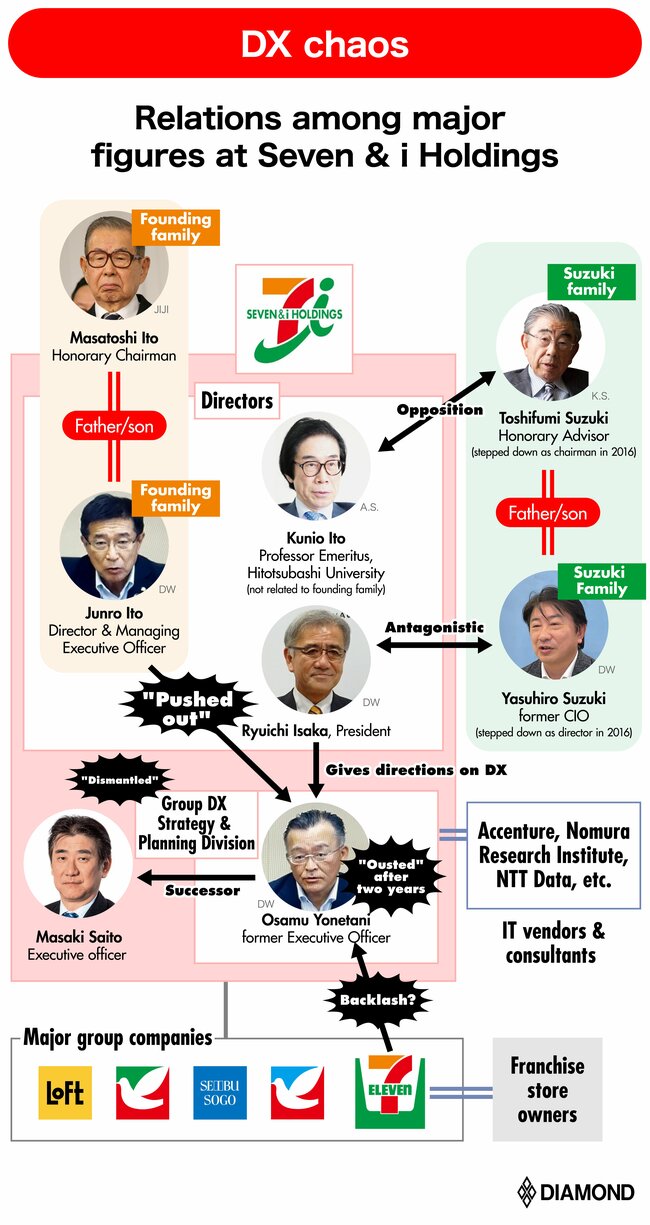Originally published in Japanese on Jan. 24, 2022
A vanishing executive
In autumn 2021, an executive at Seven & i Holdings Co., Ltd. (HD) suddenly disappeared.
Osamu Yonetani, the former executive officer, was the most important figure leading the company’s digital transformation (DX) strategy. Until that point, Seven & i had been enthusiastically pushing its DX strategy.
Yonetani was previously the chief technology officer at Recruit Technologies, which handles information technology (IT) measures for the entire Recruit Group. He successfully led projects like integrating internet service IDs, has written several books and is well known as an expert on IT issues and systems management.
He joined Seven & i in February 2019, and in April 2020 he was chosen to lead the Group DX Strategy & Planning Division, which was created within HD to implement and monitor its digital strategy. Yonetani managed the DX initiatives at the distribution giant that employs over 130,000 people.
Then the hand-at-the-rudder quietly disappeared.
Yonetani’s name was removed from the list of directors and executive officers on the company website, although there was no official announcement of leadership changes. Inside the company, however, his departure was accepted as a fait accompli.
The change was not a typical shuffle of the company leadership. There is an inconvenient truth behind it: Yonetani’s departure was a de facto ousting, and it is evidence that Seven & i’s DX strategy ended just shortly after it began, despite consuming massive amounts of manpower and funding.
What was behind the collapse of Seven & i’s DX plan? In-house documents obtained by Diamond tell the story.
 Company documents contain a full and detailed description of Seven & i’s “defeat in the DX war”.
Company documents contain a full and detailed description of Seven & i’s “defeat in the DX war”.
The fiasco involved a messy conflict with a director from the company’s founding family and difficulty controlling the group’s powerful companies, like 7-Eleven Japan. External IT vendors and consultants also got wrapped up in the company turmoil. Seven & i summarized the reasons for the disastrous failure of its DX strategy in internal documents. The documents also shine a spotlight on fundamental challenges that company has long faced.
“DX strategy is not simply the introduction of IT tools, and it requires fundamental management reforms.”
This maxim, frequently repeated as a lesson-learned from successful DX, applies perfectly in the case of Seven & i. Its DX failure fit textbook descriptions so perfectly that it should be taught in business schools.
Political intentions
An internal document dated July 5, 2021, and consisting of a 63-page report and a 40-page appendix was summarized by leading consultant Deloitte Tohmatsu as follows:
“[This document] visualizes the initiatives of the overall DX strategy; objectively takes stock of the views of HD, the DX headquarters and the group companies; and lays out a future direction.”
This interim report says its objective is to assess and verify the DX strategy at Seven & i that is being led by Yonetani.
However, a person familiar with the situation at Seven & i summarized the report differently: “Its goal was to repudiate the DX strategy until now and the role of the headquarters for DX strategy as the control tower.”
A close reading of the report lends credence to such a view. Although the document was produced by a third-party, it is clear that the report was compiled with the political intention of ousting the DX headquarters.
“The system comes first, and the business of each group company is an afterthought.”
Similar negative comments from the group companies directed toward Yonetani’s DX headquarters feature repeatedly throughout the report.
One of the companies stressed during an internal meeting that it “would like to see [the DX headquarters] move closer to the companies and show an attitude of trying to meet the companies’ expectations.”
Such language is blunt for Japan’s staid business world, and similar searing criticisms of the DX headquarters appear over and over in the report.
Collapse begins
Money also features prominently in the report.
“Self-manufacturing” was key to Yonetani’s strategy, which means the group would build and operate its own system. This required lavish investments in IT. As a result, the headcount and budget of the DX headquarters skyrocketed.
The interim report attacked that trend, disclosing in detail the amounts spent on IT vendors and consultants. It harshly criticized the lack of budgetary governance at the DX headquarters.
However, a review of the organizational structure implemented on June 21, 2021 — two weeks before the date of the interim report — indicates the assault on Yonetani’s strategy began even earlier. This is where the dismantlement of the DX headquarters, and Yonetani’s strategy with it, began.
In this reorganization, Yonetani made a horizontal move to become the head of the newly-created Group DX Solution Division. At the same time, Masaki Saito, an executive officer who used to work at Mitsui Co., Ltd. and is known to have a strong grasp of IT systems, was appointed to another new organization, the Group DX Promotion Division.
The absolute opposition between the original DX headquarters under HD and the group companies had become a major issue, and complaints from the group companies were widespread. “It’s difficult to communicate with them,” the companies said of the old DX headquarters, according to sources familiar with the situation.
Dismantling the original DX headquarters could be said to have functioned as a safety valve for the growing pressure from the group companies.
The authority to formulate DX strategy for the entire group was stripped from Yonetani and transferred to the Group DX Promotion Division. Communication with the group companies was also entrusted to the division, while Yonetani’s group was downgraded to merely oversee the self-manufacturing systems.
In other words, the reorganization was a major pushback to the DX strategy the group had previously pursued.
The presence behind this change was Director and Managing Executive Officer Junro Ito, the second son of Founder and Honorary Chairman Masatoshi Ito.
“He doesn’t make a point of reminding everyone of his status as a member of the founding family, but others naturally listen to his opinion,” said a company insider. The presence of a member of the founding family had a major impact on the brawl over the DX strategy.
Ito took control of the DX division, overseeing the work done by Yonetani. Ito is considered to be a “total layman when it comes to systems or IT,” according to the company insider. It is generally understood in the company that Ito took over despite his lack of expertise because the infighting between Yonetani’s DX headquarters and the group companies had become too intense to overlook. However, some thought that “Ito had been indicating his dissatisfaction with the performance of the DX team,” said another company insider.
In addition to Yonetani and Ito, many other figures were involved in the company’s “defeat in the DX war.”

The interim report that triggered the exit from the DX strategy listed six problems, including a “lack of a control function” and a “lack of governance capability.” It also noted that distrust within the company developed as a result of these issues. Put simply, it laid these problems at the feet of the original DX headquarters.
The last page of the report includes the phrase, “a redefinition of the entire picture of the group’s DX strategy.” It was a refutation of the DX strategy the group had pursued for more than a year and the death knell of Yonetani’s initiatives and his DX headquarters.
DX undone
The origin of Seven & i’s DX strategy was a cross-sectional group strategy titled, “Offensive DX, Defensive DX” that was laid out an HD meeting in August 2020.
Yonetani had been implementing DX measures based on this plan, including major projects like the “Last Mile DX Platform” that was intended to function as a cross-sectional platform for the systems of the entire group, improving the efficiency of home delivery services. Some of these are still under way.
However, Yonetani’s influence could be clearly seen in steps like the consolidation of IT functions to HD. The idea was to centralize the different IT operations of the group companies in HD, which would help to reinforce security measures. It was typical of the “collectivizing” DX steps that were centered around HD.
Similar issues cropped up in the mass hiring of IT personnel. About 150 mid-career IT experts were recruited from the autumn of 2019 to 2021 to develop and operate the group’s original system. The plan called for increasing that number to 600 by 2025. Seven & i developed a reputation in the recruiting business for spending vast sums of cash to gather IT personnel.
Moreover, the centerpiece of the strategy was to be the creation of a new organization for the IT specialists within the group. The plan, carried out behind closed doors, was to launch a new company in March 2022 that would merge with Seven & i Net Media, HD’s IT subsidiary that works on systems development and operations.
The project was called the “Rice Project” by those involved, a play on the name of Yonetani, which include the character for rice. Some in-house materials even used a logo featuring a rice stalk.
The Rice Project, which reflected the DX philosophy of Yonetani, was the reason Seven & i was actively recruiting so many IT workers. However, the biting conclusion of the interim report made a course-change in Yonetani's strategy unavoidable.
He surrendered unconditionally.
The dynamics are made clear in the exchanges between Yonetani and Ito. According to a person familiar with the matter, Yonetani reported to Ito about the future DX policy following the conclusions of the interim report.
In his report, he first apologized for the multiple problems, saying, “They resulted in further distrust from the group companies. I understand a mere apology is not enough, but I apologize sincerely.” He then discarded his own plan, saying “it is becoming less necessary to recruit so many people [for IT],” and “the establishment of the new company [under the Rice Project] may not be essential.”
After that, the conclusion was foregone. Yonetani, having undercut his own strategy, lost his place within the group. Shortly after his exchange with Ito, he offered his resignation after being effectively ousted from the group.
In October 2021, just three months after the interim report, Ito officially announced Yonetani’s resignation at a company meeting, adding that the Rice Project would be sent back to the drawing board and the mass recruitment of IT personnel would end.
There was naturally some backlash to Ito’s rough tactics within the IT division. However, most of it has quieted by this point. One employee in the IT division wryly described the current atmosphere in the company as “playing a game of Old Maid” — everyone is waiting to see who will quit first.
Around the same time Yonetani resigned, other IT specialists who left their previous jobs to join Seven & i, dreaming of revolutionizing the distribution giant, began to gradually quit. The break down continues following the collapse of the DX strategy.
(Originally written in Japanese by Kazuki Nagoya, translated into English by Erklaren, Inc. and edited by Connor Cislo)











